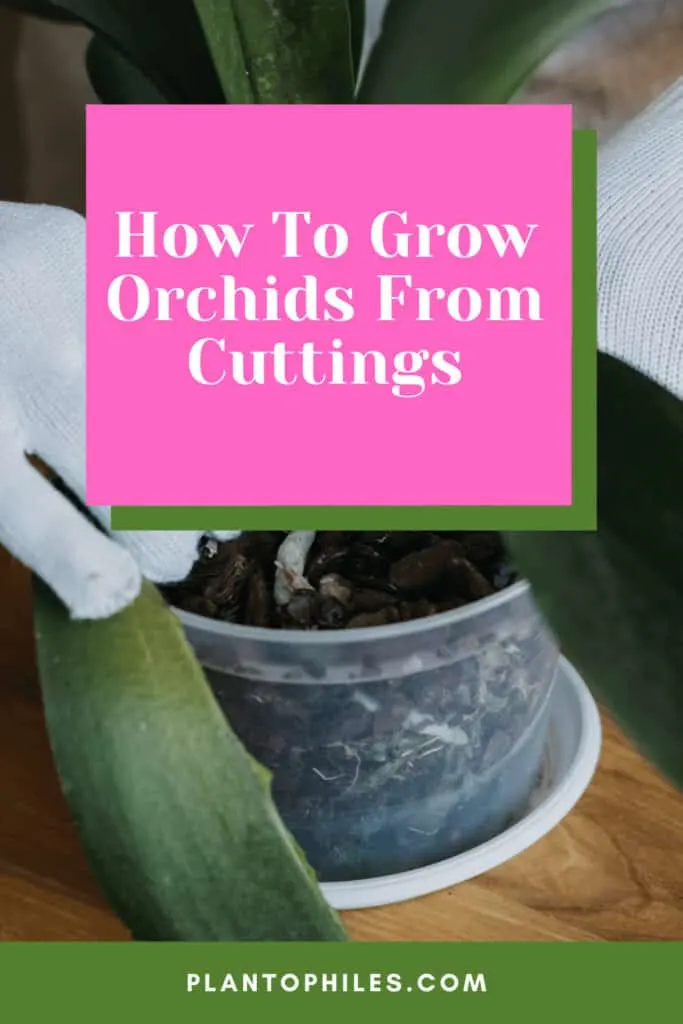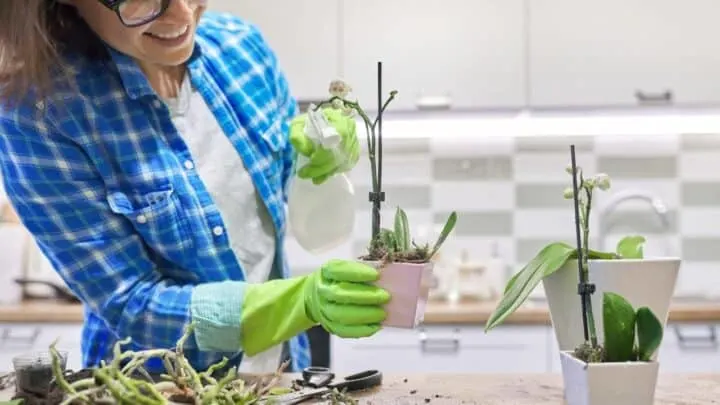How To Grow Orchids From Cuttings. Orchids are both spectacularly beautiful and notoriously full of nonsense. Although, the latter isn’t strictly true.
At the heart of it, they’re quite easy to care for and can continue to live and bloom year after year, so long as there is some understanding about what makes caring for them different from caring for other plants.
Consequently, I’ve found that once orchid owners have gotten into the groove of looking after them, they are ready to move on to the next stage – propagating.
There is much conflicting information about whether orchids can be grown from cuttings, but the simple answer is yes.
Certain orchid plants (not all) will grow from cuttings quite successfully.
Table of Contents
How to grow orchids from cuttings?
Remove a tall stem from the parent plant to grow orchids from cuttings. Place this cutting in a moisture-dense environment while waiting for new growth. Another way is through detaching and repotting plantlets from the larger orchids. Lastly, you can cut rhizomes from a mature plant.

3 Methods in Propagating Orchids from Cuttings
There are three popular methods for growing orchids from cuttings.
Firstly, one can attempt stem cutting, which involves removing a tall stem from a parent plant (at least 1ft/30cm) and dividing it into segments with three to four nodes each.
These stem sections are placed in moisture-dense environments while awaiting new growth.
Keiki cutting is a second option and refers to the detachment and repotting of small individual plantlets that have developed on the stems of larger orchids.
Rhizome cutting is a third possible propagation technique, and entails dividing a mature plant’s pseudobulbs, stems, and leaves into multiple plants.
How to Grow Orchids From Stem Cuttings
The first step is to prepare their growing tray when attempting propagation from stem cuttings. A seed tray, or something similar, will work well for this.
Once I have selected a tray, I line it with a material that retains water like sphagnum moss, and not soil.
Moss will allow for air to circulate between the cuttings’ developing roots.
Next, I select a stem that is tall, thick, and healthy as possible.
I always cut the stem above my orchid’s leaf joint, preferably above a node. That way, the cut on the stem will bring forth new growth.
Once carefully removing my chosen stem from the parent plant, I slice it into smaller sections, each with a minimum of three to four nodes.
It is important to do this in a sanitary environment to protect the plant from any disease or threat.
Finally, I lay my cuttings on the moss, a decent distance apart from one another, so that the tray does not become crowded as they grow.
As an added measure for retaining humidity, I like to cover my seed tray with a layer of clear plastic.
The cuttings must not be in direct sunlight but in a shady, humid spot.
Growing New Orchids through Keiki Cutting
Keiki is a Hawaiian word that quite literally means ‘baby.’ Thus, orchid keikis are simply what we call small plantlets that have developed on the stems of larger, more mature plants.
To grow orchids from keikis, one must wait until their roots are between 2 and 4 inches (5 to 10 centimeters) long, and they have developed two to three leaves.
When this happens, the babies can be detached and placed in their new pots with sphagnum moss.
Their roots should be close to the surface of the moss, and they must be kept away from direct sunlight.
Read my Keiki Cloning Paste review.
Growing Orchids through Rhizome Division
Rhizome cutting, or rhizome division, is successful only when an orchid is mature and has finished flowering. It requires the presence of active pseudobulbs on the stems of the plants.
A rhizome is the lateral-growing horizontal stem beneath orchids from which the leaves and vertical stems are borne.
Pseudobulbs are storage organs that develop on orchid stems to store water, carbohydrates, and minerals.
Active pseudobulbs have leaves and roots, whereas dormant pseudobulbs do not.
Mature orchids can be propagated by carefully cutting between active pseudobulbs and gently slicing through the plants’ rhizomes.
The cuttings can then be replanted in separate pots. Active pseudobulbs should take quite nicely in appropriate growing conditions.
Dormant pseudobulbs will likely remain inactive for many months but have been known to produce new orchids eventually.
Frequently Asked Questions About How To Grow Orchids From Cuttings
Will my orchid grow back if I cut down its stem?
As mentioned earlier, your orchid will grow even if you cut down its stem. Once an orchid stem has died away after blooming, you can expect a new flower spike to grow back in its place. If you cut away a stem to use for cuttings, it can also grow back, provided it is snipped above a node.
How many months before orchids bloom?
This depends on the plant. Some orchids bloom after a month or two, and some bloom after several months of dormancy. Some orchid varieties only bloom annually.
How do I tell if my orchid is growing a root or a flower spike?
Root tips and flower spikes differ in positioning, shape, and appearance. Flower spikes generally grow between the orchid’s leaves and to the side, whereas roots can grow from anywhere on the plant. Regarding their shape, flower spikes are pointy and thin compared to the rounder, thicker roots of the orchid. When it comes to appearance, flower spikes are quite sharp in shape, whereas the roots are much more rounded. In addition to this, spikes are usually much greener and less glossy than roots.
Conclusion
Although orchids can be quite tricky to look after, little compares to the satisfaction they provide as houseplants and the anticipation of waiting for their new buds to spring open.
Propagating orchids may seem quite daunting initially, but it can also be gratifying if I am careful and patient.
With sufficient moisture, indirect light, and a clean and vigilant approach to cutting, these showy delights can provide many more plants to add to your collection.
You can remove a large section of a stem and put it in high humidity to grow orchids from cuttings.

Daniel has been a plant enthusiast for over 20 years. He owns hundreds of houseplants and prepares for the chili growing seasons yearly with great anticipation. His favorite plants are plant species in the Araceae family, such as Monstera, Philodendron, and Anthurium. He also loves gardening and is growing hot peppers, tomatoes, and many more vegetables.


